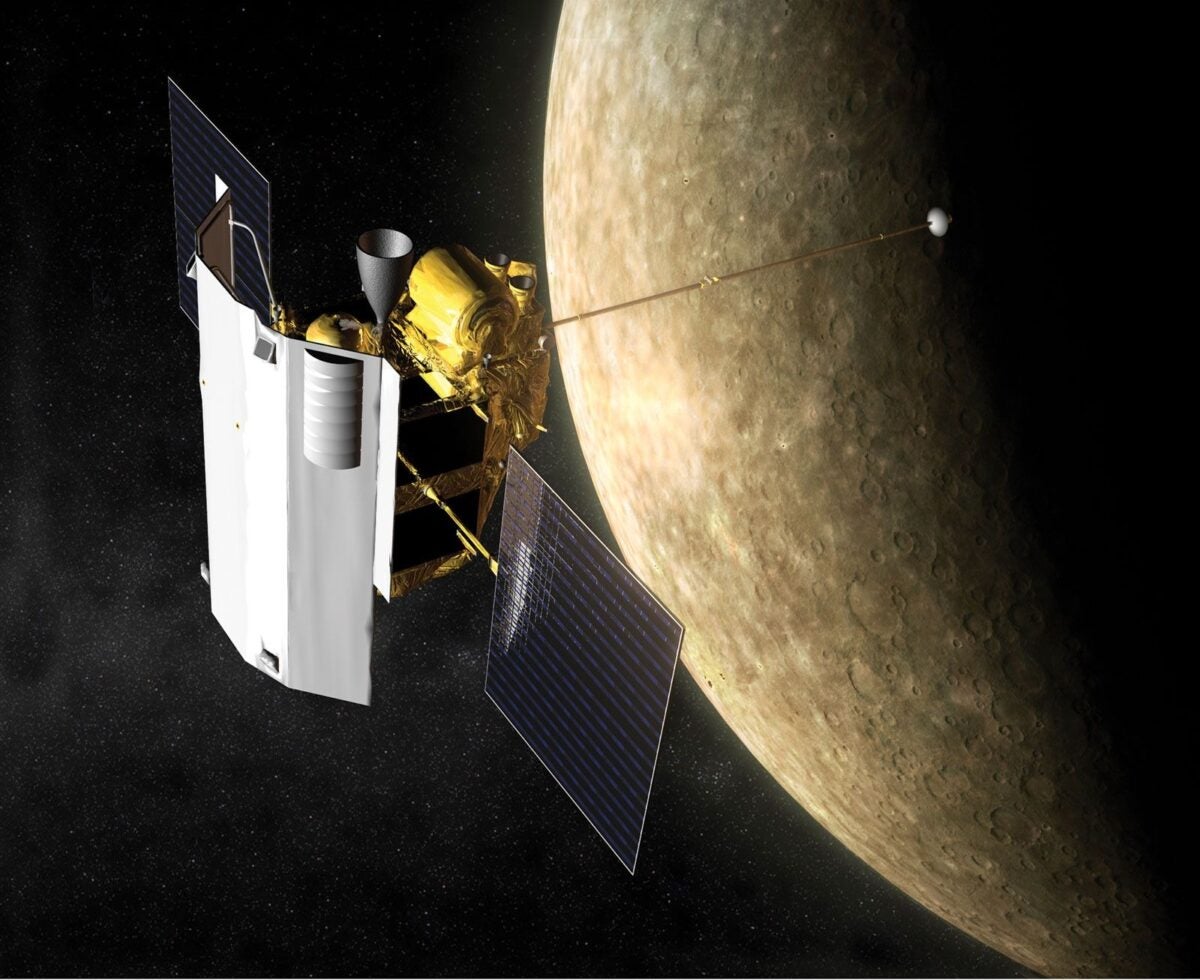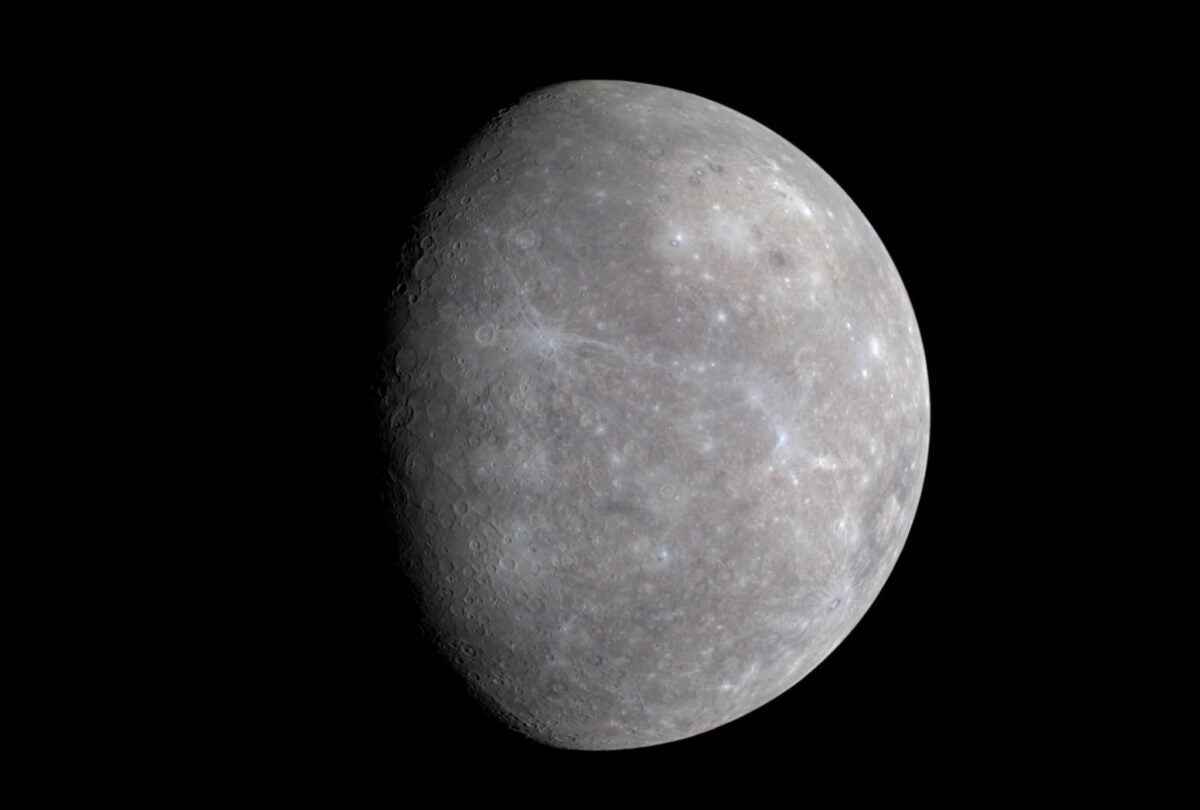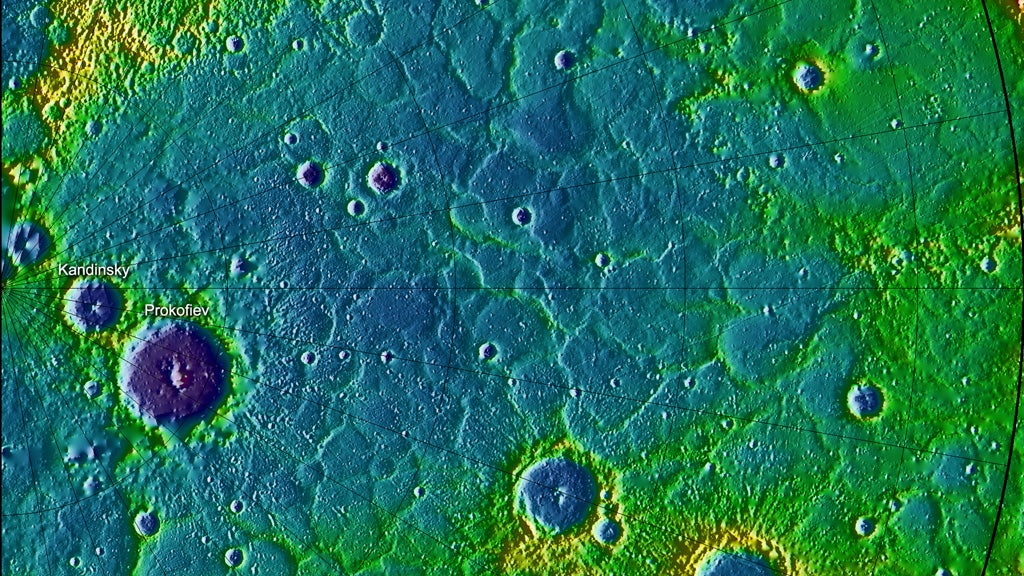
Just south of Mercury’s equator lies a crater honoring Czech composer Leoš Janáček. Battered and time-worn, it sits amid countless others dotting the barren, broiling terrain of the solar system’s innermost planet. Nearby is a truck-trailer-sized depression gouged by a visitor from Earth launched 20 years ago this month: NASA’s MESSENGER.
Only the second spacecraft to ever visit Mercury, MESSENGER gave us our first complete picture of the planet, surveying its entire surface and studying its core and atmosphere. But its most enduring legacy may be in finding water ice — one of life’s fundamental building blocks — in a Sun-seared, radiation-drenched wasteland wholly hostile to life. It was a truly remarkable example of nature’s ability to surprise and astound.
Early explorations
Three times nearer the Sun than Earth, diminutive Mercury orbits our star every 88 days at an average distance of 36 million miles (58 million kilometers). And with the Sun three times larger and 11 times brighter in Mercury’s coal-dark sky, this grey-tan planet of craters and scarps, mountains, and plains, curiously resembles our Moon, albeit with a diameter 40 percent larger and 60 percent denser. Its surface area of 29 million square miles (75 million square kilometers) roughly equates to the combined landmasses of Asia and Africa.
But for millennia, it remained mysterious. Mercury is easily lost in the Sun’s glare, making observations difficult, save for glimpses at nightfall or before dawn. Mercury’s rapid motion across the sky earned it repute as the gods’ messenger — from the Greek Hermes with his winged sandals to the Latin root of its modern name, Rome’s Mercurius, with his serpent-entwined staff.
Reaching the innermost planet, paradoxically, is tougher than getting to the outermost. Space probes must plunge deep into the Sun’s gravitational well and are naturally accelerated inwards, risking missing Mercury entirely. This stark truth required Mariner 10 — the first mission to visit Mercury — to use Venus’ gravity to tweak its flight path.
Between March 1974 and March 1975, Mariner 10 zipped past Mercury three times. Its approach angle viewed only Mercury’s sunlit eastern hemisphere and imaged 40 to 45 percent of the surface. The rest lay in darkness, though the colossal 3.85-billion-year-old Caloris impact basin ventured teasingly into partial view.
Mariner 10’s observations revealed rugged highlands and smooth lowlands, a tenuous atmosphere made mostly of helium, a feeble magnetic field just 1 percent the strength of Earth’s own, and traces of a nickel-iron core. Surface temperatures on the planet swung from 400 degrees Celsius (750 degrees Fahrenheit) by day to –180 C (–290 F) at night. The probes also searched for moons but found none.
A new messenger
Thirty years passed before humanity’s next mission to Mercury. And in that time, our perceptions of the planet also shifted. Ground-based observations had detected bright spots in permanently-shadowed polar craters that resembled water ice.
Investigating these tantalizing spots was one of the goals of the new $450-million mission, named MESSENGER. (The moniker, a product of NASA’s finest acronym-makers, was short for MErcury Surface, Space ENvironment, GEochemistry and Ranging.) Built by Johns Hopkins University, the six-foot-tall (1.8 meters) probe was also designed to investigate Mercury’s high density, geological evolution, magnetic field, core, and exosphere.
MESSENGER’s seven instruments included cameras to map Mercury at resolutions finer than 800 feet (250 m) and gamma-ray, X-ray, and neutron spectrometers to assess mineralogy and seek water ice. Other instruments scanned its exosphere, magnetic and gravitational fields. All were sheltered from the intense heat behind a ceramic-fabric sunshade. Rotatable solar panels and optical reflectors also helped keep temperatures at survivable levels.
The mission’s launch was postponed from March 2004 to May of that year and then to midsummer by hardware woes, technical maladies, and poor weather. MESSENGER rose from Cape Canaveral’s Launch Complex 17B at 1:15 a.m. EDT on Aug. 3. “A planetary enigma in our inner solar system” was the launch commentator’s remark as the Delta II rocket speared into the Florida darkness, commencing a 6.5-year voyage of 4.9 billion miles (7.9 billion km) to reach Mercury.
The delays had already pushed MESSENGER’s arrival from April 2009 to March 2011. Unlike Mariner 10, it would enter an elliptical orbit around the planet — an astonishing feat of celestial mechanics facilitated by a complex series of gravitational boosts from planetary flybys.
Departing Earth that August night at 24,000 mph (38,600 km/h), MESSENGER returned home in August 2005, passing high over central Mongolia. Its looping solar orbit then carried it twice past Venus in October 2006 and June 2007. Those gravitational slingshots shrank the radius of MESSENGER’s solar orbit and drew it inexorably closer to Mercury.

MESSENGER arrives
Three times between January 2008 and September 2009, the probe swept to within 125 miles (200 km) of the planet and imaged 98 percent of its surface, including much of the western hemisphere, leaving only the poles left uncharted.
It observed chains of cliffs snaking across the brutalized terrain and over a hundred narrow, flat-floored troughs at the heart of the Caloris basin, which the mission team nicknamed “the spider.” (Today, the feature is called Pantheon Fossa.) And MESSENGER pegged Caloris’ diameter at 960 miles (1,550 km) — wider than Texas, embayed by a ring of forbidding mountains taller than four Empire State Buildings piled atop one another.
Newfound surface features gained names. Cliffs were named in honor of ships like HMS Beagle and the Alvin deep-ocean submersible; craters memorialized authors, artists, and musicians including J.R.R. Tolkien, Muddy Waters, Walt Disney, and John Lennon.
The flybys also yielded several other major results, including the unexpected discovery of water in the planet’s atmosphere as well as evidence for a still-molten core and ancient volcanism. MESSENGER also found that Mercury’s magnetic field can be “leaky,” allowing the Sun’s wind of charged particles to penetrate to the planet’s surface. This is key to the survival of Mercury’s atmosphere: When solar-wind protons strike the planet, they can fling surface particles upward, replenishing the thin atmosphere.
But those entrée courses merely whetted scientists’ appetites for the main dish: MESSENGER’s arrival in orbit on March 18, 2011. Its hydrazine engine burned for 15 minutes, slowing the probe by 1,930 mph (3,100 km/h) and slipping into an elliptical 12-hour orbit. At its nearest point, the craft would dip as near as 125 miles (200 km), but the rest of the orbit took it as distant as 9,400 miles (15,200 km) to guard against heat radiated from the planet’s surface.
Ninety-six million miles (155 million km) away, on Earth scientists and engineers whooped with delight when the orbital insertion was confirmed.
Monitoring Mercury
During its year-long primary mission in orbit, MESSENGER found Mercury’s magnetic field to be offset far to the north of the planet’s center, compiled precise gravity-field maps, and revealed ubiquitous volcanic activity as recently as a few tens of millions of years ago.
Notably, Mercury’s smooth northern polar plains constitute the largest volcanic deposits; their thicknesses as great as 1.2 miles (2 km) were revealed by analysis of buried “ghost” craters. Remnants of ancient vents 15.5 miles (25 km) wide reinforced a picture of pervasive volcanism throughout Mercury’s history.
In March 2012, MESSENGER began a mission extension. In April, an engine burn reduced its orbit to eight hours to investigate its chemical composition, geological evolution and environment. A detailed 3D map of Mercury was published in February 2013. And by the end of that first extension, the probe had mapped the planet’s entire surface.
But MESSENGER’s most dramatic discovery, announced in November 2012, was near-pure water ice in permanently-shadowed polar craters. Since Mercury has a negligible axial tilt, these craters’ floors are eternally dark, forming “cold traps” that can hold volatile gases in frozen form for long geological periods. This water ice is likely insulated by a radiation-darkened layer of hydrocarbons as temperatures are too warm for it to be stable at the surface.

A second mission extension from March 2013 found that Mercury’s nickel-iron core extends up to 85 percent of its radius, detected over 50 ancient pyroclastic flows from low-profile shield volcanoes and was able to obtain optical evidence for water ice deep within craters. Although most deposits are permanently shadowed, imaging refinements leveraged low light levels scattered from illuminated crater walls, revealing that the 69-mile-wide (112 km) Prokofiev crater hosts bright material along its southern rim.
Related: The mystery of Mercury’s hollows
A legacy of exploration
As MESSENGER’s orbit slowly degraded and its hydrazine fuel ran dry, the end drew nigh for the probe. Engineers got ingeniously creative with what they had left by repurposing the engine’s helium gas — originally used to pressurize the engines — as propellant to make trajectory refinements as the probe continued to admirably conduct science.
On 30 April 2015 MESSENGER impacted the planet near the 29-mile-wide (47 km) Janáček crater, ending a mission that had travelled 8.7 billion miles (14 billion km), circled Mercury 4,103 times, and snapped 300,000 photographs.
Luckily, the 30-year gap between Mariner 10 and MESSENGER will not be repeated. In fact, Mercury already has another visitor at its doorstep: BepiColumbo, a joint venture between the European Space Agency and the Japanese space agency JAXA. The mission is currently in its flyby phase, buzzing Mercury as it prepares to slip into orbit around the planet in December 2025. The mission will deploy two probes that will orbit Mercury, examining its surface, interior, atmosphere, and magnetic field — all building on MESSENGER’s illuminating legacy.









